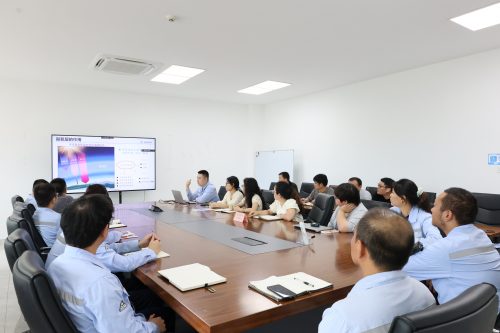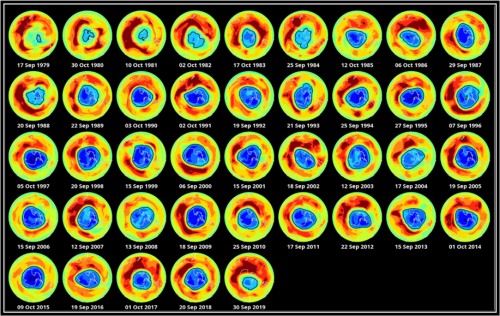September 16, 2024 marks the 30th “International Day for the Preservation of the Ozone Layer”.

As an innovative enterprise in the field of substitutes for ozone-depleting substances (ODS), Quanzhou Yuji held a science popularization lecture titled “Empowering ecological guardians with technology and jointly drawing a blueprint for ozone protection” on the morning of September 14. Through a combination of online and offline formats, all employees were organized to learn about ozone layer protection and understand the company’s technological innovations in protecting the ozone layer and addressing global climate change. This initiative aims to pool the strength of all employees to jointly promote global environmental sustainable development and safeguard our beautiful earth.
For many years, Quanzhou Yuji has been closely following global environmental governance international conventions such as the Vienna Convention for the Protection of the Ozone Layer, the Kyoto Protocol, the Paris Agreement, and the Kigali Amendment. The company actively conducts research and development and industrialization of products with zero ODP and low GWP100 values, providing environmentally friendly fluorine-containing new materials to the market.
This year, Quanzhou Yuji put forward the definition of the fifth-generation ODS substitute internationally: zero ODP, low
GWP100, and no generation of trifluoroacetic acid (TFA) upon degradation.
At the same time, the company’s independently developed fifth-generation ODS substitute has become the first to achieve industrialization in Quanzhou. A production facility on a hundred-ton scale has been built, which can be applied in fields such as refrigeration, foaming, and cleaning. Moreover, the company is continuing to conduct molecular design, calculation, screening, and application research with full force to invent more fifth-generation products that do not generate TFA upon degradation.
Quanzhou Yuji will leverage technology to collaborate with partners and serve customers and the market with products of zero ODP and low GWP100 values, contributing to protecting the ozone layer and safeguarding our blue planet.
The ozone layer:
The ozone in the stratosphere absorbs the ultraviolet radiation harmful to organisms in sunlight. The area with the highest ozone concentration in the stratosphere is known as the ozone layer. The ozone layer can absorb ultraviolet rays with wavelengths below 300nm in sunlight. Like a huge “protective umbrella”, it shields humans, animals, and plants on Earth from the harm of short-wave ultraviolet rays.
The Antarctic ozone hole:
In 1985, scientists discovered that in the atmosphere above the Antarctic, the ozone content began to gradually decrease, especially in September and October each year (equivalent to spring in the southern hemisphere). This phenomenon is called the Antarctic ozone hole.
Ozone-depleting substances:
Scientists have found that the production and consumption of ozone are in a dynamic equilibrium, maintaining the ozone concentration in the atmosphere within a relatively stable range. However, some chemical substances created by humans (ozone-depleting substances, abbreviated as ODS) have disrupted this balance. After these substances are released into the atmosphere and rise to the stratosphere, they decompose into free radicals under ultraviolet irradiation. These free radicals react with ozone, leading to the destruction of the ozone layer and even the formation of ozone holes.
Ozone-depleting substances mainly include chlorofluorocarbons (CFCs), halons, carbon tetrachloride and methyl chloroform, hydrofluorocarbons (HCFCs), etc. They mainly originate from industrial production and consumption processes, such as refrigerants, foaming agents, fire extinguishing agents, and so on.
International actions to address ozone depletion:
In 1985, 28 countries around the world signed the Vienna Convention for the Protection of the Ozone Layer, establishing the principles of international cooperation in protecting the ozone layer. In 1987, the Montreal Protocol on Substances that Deplete the Ozone Layer (referred to as the Montreal Protocol) was adopted, setting up the framework for international cooperation in global ozone layer protection and controlling the above-mentioned ozone-depleting substances. Subsequently, this protocol has been continuously revised. For example, the Kigali Amendment adopted in 2016 further restricts the use of hydrofluorocarbons (HFCs), opening a new chapter in coordinated protection of the ozone layer and addressing climate change. China joined the Montreal Protocol in 1991 and the Kigali Amendment in 2016.
Driven by various conventions and regulations, the global chemical industry has embarked on the substitution process of ODS. Currently, the fourth-generation product hydrofluoroolefins (HFOs) used internationally already has the characteristics of zero ODP value, short atmospheric lifetime, and extremely low GWP100 value.

Changes in the scope of the largest ozone hole from 1979 to 2019
Global actions are gradually yielding results. According to the tenth assessment in 2022, since the implementation of the Montreal Protocol, countries and regions around the world have continuously reduced ozone depletion by actively adopting substitutes. The total chlorine concentration of ODS has decreased by more than 11% from the peak of 3660 ppt (the number of molecules of this gas contained in every trillion gas molecules in dry air) in 1993, and the total bromine concentration has also decreased by more than 15% from 22.1 ppt in 1999. The report believes that the world has phased out nearly 99% of banned ozone-depleting substances, successfully protected the ozone layer, promoted its significant recovery, and reduced the harm of solar ultraviolet radiation to humans. If the current protection policies are maintained, it is expected that by 2040, the ozone layer in other regions of the world except the North and South Poles will return to the level before 1980.
Quanzhou Yuji: Empowering with technology and protecting the ozone layer.
Quanzhou Yuji has mastered a large number of core technologies in the manufacturing of new-generation chlorofluorocarbon substitutes, such as fluorine-containing refrigerants, foaming agents, and cleaning agents. The company is actively developing fifth-generation products to address the ozone consumption problem, reduce the greenhouse effect, and avoid generating toxic TFA upon degradation.
Develop and produce etching gases for advanced processes of chips below 14nm.
Propose and develop electronic specialty gases with dual functions of etching and cleaning.
With zero ODP and low GWP, it promotes the sustainable development of the global semiconductor industry.
As a new generation of environmentally friendly insulating gas, heptafluoroisobutyronitrile (C4F7N) has zero ODP and a GWP100 value much lower than that of the super greenhouse gas sulfur hexafluoride. Quanzhou Yuji is one of the first enterprises in the world to master the synthesis and manufacturing technology of C4F7N environmentally friendly insulating gas. The product has been successfully applied in domestic and foreign medium and high voltage environmentally friendly power equipment, continuously providing high-quality products to domestic and foreign leading power equipment enterprises including Fortune 500 companies.
In the fields of immersion coolants and lithium battery electrolyte additives, Quanzhou Yuji also adheres to the concept of environmental protection and low carbon and continuously develops new products.